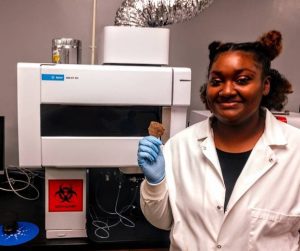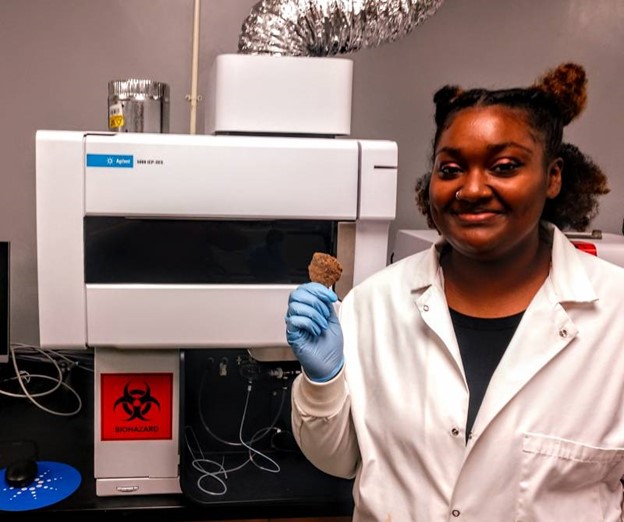Special to The Clinton Courier

Takaye Farmer, a senior chemistry major at MC, holds a pottery shard that will be crushed, prepared, and fed into the state-of-the-art ICP-OES instrument for analysis.
Research into the chemical composition of pottery shards taken from archeological digs in the Holy Land by Mississippi College faculty and students has revealed significant social networking and trade routes that verify certain accounts contained in the Bible.
Using state-of-the-art inductively coupled plasma-optical emission spectrometry (ICP-OES) equipment, students in the Department of Chemistry and Biochemistry at MC analyzed the elements contained in each of the samples from throughout Israel and Corinth, Greece.
They discovered ceramic pottery from such places as Jerusalem, Jericho, Masadah, Herodium, Timnah, En Gedi, Bantas, and Hazor display the same, distinct characteristics, confirming that trade and cultural exchanges took place between merchants and residents of these cities.
Scoty Hearst, assistant professor in the Department of Chemistry and Biochemistry and Environmental Chemistry Team leader, said the findings indicate strong social connections between these ancient civilizations that bring the truth of the Bible to life.
“We hear about all these places in the Bible, so it’s neat to see that there were social and trade routes between them,” Hearst said. “It brings the stories about Samson and Delilah and King Herod home and makes them more real. It’s great to use chemistry and science to support our Christian beliefs.”
Archeologists value pottery because its characteristics provide concrete evidence of shared culture and cultural exchange, such as ideas and trade. Over time, other evidence of a civilization may disappear, but its pottery gives historians a dependable tool to study its way of life.
The MC study took more than four decades to complete. It began when Dr. Dean Parks, professor emeritus of chemistry, and his wife, Barbara, traveled to the Holy Land on two occasions in the late 1970s to participate in certified archeological digs.
“We went with an MC student who wanted to analyze soil samples to establish population density,” Parks said. “As you dig into the earth, it’s like going through the layers of a cake – you have a layer from one age, then you go deeper and find a layer from an earlier time. Occasionally, you can see a layer that is all black, where a fire has burned everything down. For different ages, the potters had slight differences in the way they designed and decorated their pottery. After the archeologists had examined what they had found in the digs, many of them threw away the pottery shards. That’s where most of these samples came from. When we collected them, there wasn’t an easy way to analyze them, so I kept them.”
The samples Parks contributed to the study encompass the Biblical time period stretching from the early Bronze Age to the later Roman empire. Parks said he was pleased to find a useful purpose for the shards he had stored for decades.
The process for determining the pottery’s content is destructive: students grind up the samples, digest them with acid, filter them, and feed them through the ICP-OES analytical tool. The instrument can detect and measure all the elements of a sample, including carbon, lead, sulfur, calcium, magnesium and aluminum. MC recently acquired the machine for the Department of Chemistry and Biochemistry.
Hearst’s group measured the amount of seventeen elements present in the pottery samples to determine their unique characteristics. These characteristics were compared with those of other samples to yield a similarity score that could authenticate whether they had any relational value. The students developed a Social Network Analysis that connected cities with similar pottery, producing a “spider web” of the trade from Greece throughout the Mediterranean.
“If they shared common characteristics, we can assume they came from similar pottery kilns, or they were made from similar clay, or they were decorated with similar paint,” Hearst said. “If you had pottery made in one location and traded all over the Holy Land, you would find pieces of that pottery everywhere.”
As a control, the students also ran samples from Native American pottery and pottery collected from the Crusades period. Neither matched the pottery from the Holy Land.
Hearst said the study has drawn attention from the scientific community as well as art galleries that conduct chemical analysis on treasured pieces to show the science behind the art.
“What’s interesting about the pottery is you don’t know who might have had it,” he said. “Samson could have eaten from or drank from this vessel. Just holding a piece of the Holy Land in your hand makes it more realistic. It’s great for students’ education. We are a Christian college, and it’s exciting to merge our beliefs and science to show that the Bible is truth. Now we have more scientific evidence to prove it.”

